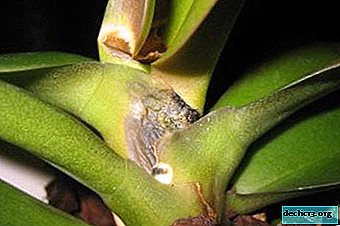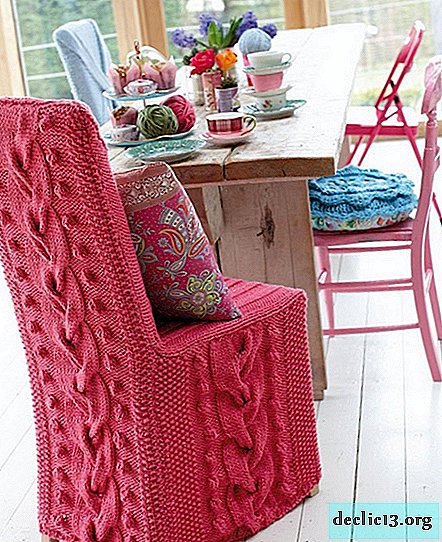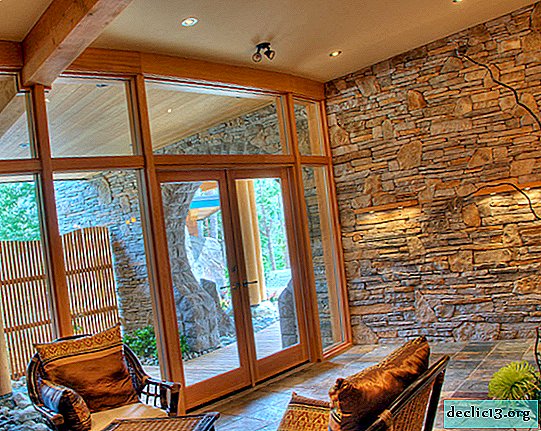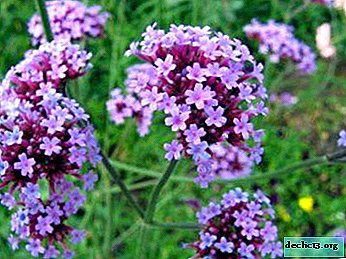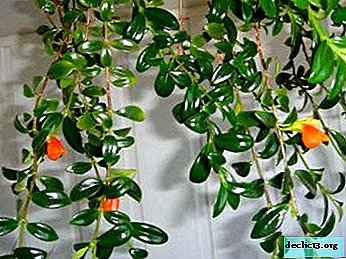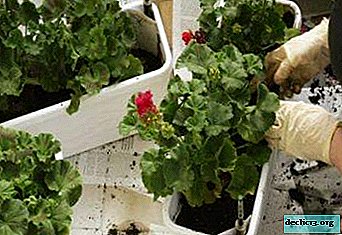Features of reproduction and care of alba, types and varieties of plants

Albuca is an ornamental plant, which is distinguished by its original appearance, and therefore attracts the attention of flower growers. The peculiarity of the plant in twisted leaves.
Snow-white inflorescences have stripes or fringes of green color. In addition, albuca has about 150 species.
Such a plant is interesting not only to gardeners, but also to children. This attractive plant with screwed leaves perfectly pleases the eye in the green corner of any hostess.
Description and Origin
Albuca is a perennial succulent plant, which is a representative of the bulb. Its homeland is the southern regions of Africa, so the plant is thermophilic. Bulb of white hue, rounded and slightly flattened. Its diameter is 5 cm. The leaves are collected near the base of the bulb into a socket.
On one plant there are 15-20 of them. The leaf length does not exceed 30-35 cm. In the winter, Albuca is at rest, dropping foliage. Only bulbs remain in the ground. As soon as winter comes, they grow roots, there is a basal rosette, which consists of twisted leaves. At the first stage, their linear forms stick out spirally.
With the onset of summer, the leaves wrap and look like a serpentine. Due to this, the sheet plate retains moisture and reduces the possibility of evaporation.
Cultivation and reproduction
When to plant and whether it is possible to grow not at home?
 Since Albuca is a heat-loving culture, it is better to grow it indoors.
Since Albuca is a heat-loving culture, it is better to grow it indoors.
But if the climate allows, cultivation is allowed in the open ground. In the southern regions, heat and sunlight may be enough for the comfortable growth of this species.
For these purposes, choose a well-lit place, otherwise the plant will not grow and develop.
Planting events should be carried out in the month of March, if the bulbs are planted. Seeding is carried out at the end of February.
How to prepare the ground?
To grow Albuki, you need a loose, nutritious and light substrate. A mixture designed for succulents is great. But you can prepare the soil composition if you mix sand and sheet soil in equal proportions.
Before using the substrate, bake it in the oven at a temperature of 220 degrees.Breeding methods
Seeds
The seed propagation method for this plant is the most effective., as it allows you to get excellent and friendly crops. But this is where the benefits end. The fact is that only those seeds that have been collected recently (no more than 6 months) are suitable for planting. In addition, albuca will bloom only in the 3rd year after planting.
How to choose and prepare seeds?
As soon as the plant fades, and in the place of the flower a box with seeds is formed, then they need to be collected, and then put in a dark place for 3-4 weeks. Only after that, planting material is ready for further use.
Landing
Procedure:
- Place the prepared substrate in a container with drainage holes. You can use a box or a pot of plastic, wood.
- To spread the seeds on top of the soil without deepening into the ground.
- Spray them with spray water.
- Cover the seedlings with a film and keep them at a temperature of 28 degrees.
- As soon as 2 leaves are formed, then dive, planting the plants in separate containers.
Bulbs
 This method has several advantages:
This method has several advantages:
- ease of action;
- reliability, since the new plant will retain all the signs of its parent;
- young shoots are stronger and more resistant to disease.
Of the minuses, only that the bulbs are difficult to keep healthy unless certain conditions are met.
Unprotected bulbs are exposed to negative external influences. They can be affected by pests, fungi.
Dig out planting material in the fall, and then place in a dark and cool place. Before planting bulbs form young and straight leaves.
Procedure
For planting you need to use light soil. The procedure is as follows:
- Lay a layer of drainage using expanded clay, and then fill the container with earth.
- Deepen the bulbs of the plant into the soil, observing an interval of 5 cm.
- Depth of landing should not be more than 8 cm.
- It is impossible to bury them too deeply, since this is a vegetative part and it must retain moisture.
Follow-up care
The first shoots are formed after 2 weeks. Now you need to organize watering. This should be done carefully so as not to allow waterlogging. Initially, the leaves will be straight, but they will begin to twist only under bright lighting. You will have to take care of installing additional lamps.
If you grow album from seeds, then in the first year, bulbs are formed. But it will bloom only in the 3rd year. If the plant does not take root, then there may be several reasons. Most often this happens due to poor-quality planting material, improperly selected substrate and non-compliance with the conditions of detention.
Basic Rules
Watering
During the active growth, flowering and development of albuca requires abundant hydration. But watering the plant is only provided that the earthen lump is completely dry.The flower has a clearly defined period of rest, in which its leaves are in a wilted state. By this time, the plant should be prepared gradually, reducing watering. And with its onset, soil moisture should be noted at all until spring. During irrigation, it is better to use settled soft water.
Temperature
 Albuca prefers to grow in high temperature. In summer, it feels good at temperatures of 25-28 degrees, and in winter - at least 13-25 degrees.
Albuca prefers to grow in high temperature. In summer, it feels good at temperatures of 25-28 degrees, and in winter - at least 13-25 degrees.
The formation of peduncles occurs due to night and day temperature differences.
In late November and early December, temperature indicators are best reduced to 10-15 degrees in the daytime and to 6-10 degrees in the night.
The soil
You need to grow album in a nutritious, loose and moist soil.. It should contain nutrients (nitrogen, potassium, phosphorus), but not in large quantities.
Shine
Albuque is a photophilous culture. For its active growth and abundant flowering, it is necessary to choose windows where there will be sunlight. It is better to grow the plant on the windows of the western, southern and eastern directions. The daylight hours are 12 hours.
Top dressing
Albuca needs regular fertilizer throughout the growing season. It is best to use mineral compounds for succulents. Dilute them with water, according to the instructions. In the spring before the formation of buds, add formulations with a high concentration of nitrogen. This will allow the bush to actively form leaves. But during flowering, such dressings will have to be reduced. You can use preparations containing phosphorus and potassium.
Content according to season
It is only necessary to grow albuca in a well-lit place, so that even direct sunlight is not afraid of it. In summer, watering should be regular and intense, but in winter, the bulbs do not need to be moistened at all.
During active growth for the culture you need to create the optimal temperature regime - 24-28 degrees. In winter, the plant requires cool air, so the temperature will be 10-14 degrees.
Albuca is able to withstand low temperatures below zero. It’s easy to take care of the plant in winter, as this is a dormant period. It is not necessary to feed and water. All that is required is to provide the necessary humidity and temperature.
The main types and varieties, their photos
Spiral (Albuca Spiralis)
This is an original plant with swirling bluish-green leaves. Under natural conditions, they allow you to survive a dry period. Spiral leaves are 35 cm long.
In the early days of summer, a fleshy peduncle begins to appear from the bulb, on which there are 20 sunny yellow drooping flowers. They are very delicate and fragrant. The peculiarity of the species is that the rest period is summer.
When growing crops, a nutritious and loose soil with a drainage layer is required. Plants can grow singly or in small groups. Spiralis propagates by seeds and bulbs.

Nelson's
This variety is the most popular among gardeners.. Suitable for indoor cultivation. The height of the culture is 75 cm. During flowering, white twigs appear on the bush, and after they wither a dark cherry longitudinal strip appears. Nelson's Albuca is propagated by seeds and bulbs, and is also cultivated as a container plant.

Canadian
This is a perennial bulbous culture, the height of which is 30 cm. It differs in the unusual structure of the flower: 3 external petals are open, and 3 internal petals are wrapped to the center of the corolla, covering the stamens.
Flowering occurs in late spring. Inflorescences are yellow-white. The leaf plate is saturated green, 15 cm long. This species needs abundant watering (2-3 times a week). Humidity is not picky, needs to be added with additional nutrients.

Bract
Bulbs have a slightly green hue. They are covered with a thin wax film. The leaves are juicy and striped, their length is 1 m. They differ in healing properties, like aloe. In addition to South Africa, the variety is cultivated in the Mediterranean and in Asia. Flowering lasts all the time.
On the white petals, a longitudinal green stripe is noticeable. The brush is large, sometimes it can consist of 100 flowers, which open alternately. In terms of cultivation, this variety is no different from the rest. It also propagates by seeds and bulbs, is rarely sick and blooms profusely.

Diseases and Pests
Albuca is a plant that is resistant to immunity, but in the absence of suitable conditions for growth and defective care, various problems can arise.
Rotting bulbs
This problem is the most common. The main reason is waterlogging. To save such a plant will not work, so you have to get rid of it. But prevention involves adjusting watering, moistening the soil regularly, but avoiding the presence of stagnant water.
Leaves turn brown
Most often, the reason for the presence of red-brown spots remains rust - a fungal disease. These spots are slightly convex. Over time, they begin to grow and increase in size. The affected leaf plate begins to dry out, fall off, and the stems in the affected areas are cracked.
If rust has affected the plant, then it can be cured if all diseased leaves are removed, and fungicides are also treated. Prevention involves normalizing watering and lighting.
Leaves do not twist
If the plant does not twist leaves, then the reason is stagnation of water. In order for the album to delight with the beauty of the spiral leaves, it needs to provide bright lighting, the duration of which is at least 18 hours a day. For these purposes it is necessary to use fluorescent or fluorescent lamps.
Fall off
If the flower began to fall off the leaves, then the following factors can affect this:
- rearrangement of the plant in the shade;
- strong temperature differences;
- a draft with a frosty wind;
- complete drying of the soil and plentiful waterlogging.
The treatment for this problem depends on what led to its development. As soon as an unfavorable factor is eliminated, the plant will immediately begin to please with a decorative look, and not with falling leaves.
Spider mite
If there is a defeat by a spider mite, then on the bush the leaves first curl, and then fall off. In the absence of timely measures, the plant may die. To combat the parasite, the grower needs to regularly inspect the flower. As soon as the pest is detected, then treat the bush with fungicidal preparations.
Root tick
 These parasites are able to live in any soil. They feed on organic debris and bacteria. The pest prefers to dwell on weakened and damaged bulbs. The root tick is not an insect, so insecticides will not help here. For treatment, it is better to use insecticaricidal agents.
These parasites are able to live in any soil. They feed on organic debris and bacteria. The pest prefers to dwell on weakened and damaged bulbs. The root tick is not an insect, so insecticides will not help here. For treatment, it is better to use insecticaricidal agents.
Organophosphorus compounds are effective. Use the following chemicals:
- Apollo
- Di-68.
- Chemidis.
- Rogor S.
- Bi-58.
In order for the treatment to be effective, but there is no addiction, it is necessary to change the drugs used. As a preventive measure, treat planting material with a solution of colloidal sulfur.
Albuque is a decorative culture that is valued not for flowers, but for elegant and original leaves. Despite the fact that the plant comes from the tropics, it is completely not picky in terms of cultivation.
The most commonly used album is for indoor cultivation. If you follow all the recommendations exactly, the culture will bloom profusely and delight you with its decorative look.




